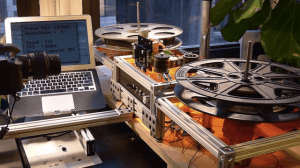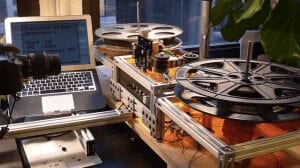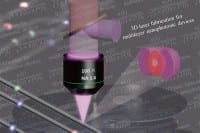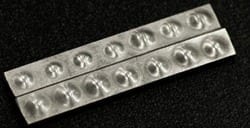
A great motivator for us in developing the Raspberry Pi was bringing down the cost of computing.
Nobody should be excluded from being able to learn about computing, or from using it for work or pleasure, by what’s in their pocket.
The pricing of electronics means that some important and useful tools have historically been outside the reach of anyone without a large chunk of capital behind them. You’ll have seen the photography hacks we feature here, which use a Pi to make very, very inexpensive versions of photography equipment like time-lapse rigs, gigapixel rigs, water droplet setups and the like. Off-the-shelf versions of equipment like this can cost thousands of pounds, but a Pi and some ingenuity can bring the cost right down to levels which are sensible and affordable. These projects are not just for amateurs: we have seen professional photographers using Pi-based, home-hacked equipment in preference to the expensive stuff. It works just the same, and there’s a lot to be said for the warm glow you get from making your work tools yourself.
It’s not just individuals and small businesses who are sometimes priced out of doing worthwhile stuff by the price of electronics. Libraries, museums and other public institutions are often priced out of being able to digitise collections by the prohibitive cost of equipment.
Kinograph is an astonishing thesis project from Matthew Epler, an artist and film historian. It’s a Pi-powered, open-source, scalable device for digitising old film stock, complete with the ability to stabilise images (another application for OpenCV) and recapture sound. A good DSLR camera is the most expensive part of the setup, at about $2000; the rest of the equipment comes to $1200. (Matthew is working on getting that figure down below the magic $1000.) Compare that to the $480,000 it would cost you to digitise 50 films on reels at a film lab, or the $175,000 it’d cost you to buy a Kinetta (the nearest commercial equivalent device) and a whole world of possibilities opens up. Film stock, be it celluloid, acetate or nitrate based, is not stable, and being able to record and save our film heritage is a pressing concern. We’ve already lost more than 90% of all silent movies, and around 50% of the films with audio made before 1950.
The Latest Bing News on:
Kinograph
- Feed has no items.
The Latest Google Headlines on:
Kinograph
[google_news title=”” keyword=”Kinograph” num_posts=”10″ blurb_length=”0″ show_thumb=”left”]
The Latest Bing News on:
Digitising old film stock
- Long Island's 2014 high school valedictorians: 10 years lateron May 7, 2024 at 10:00 pm
He graduated in August 2023 and now works as a freelance writer and filmmaker whose most recent project involved co-directing a film called “Sparni,” which tells the story of a pivotal year in the ...
- PlayStation Portal stock tracker: how to find the next dropon May 7, 2024 at 9:51 am
The PlayStation Portal stock curse may have been broken. Not only are we seeing Best Buy's recent restock still holding steady on the shelves, but Walmart is now in the game as well. That means ...
- 8 Vintage Digital Cameras Still Worth Buying Todayon May 3, 2024 at 12:56 pm
Many modern pocket cameras are difficult to get due to popular demand. If you can't wait on a back order or simply want to go retro, these older models can satisfy your creative itch.
- ‘No Longer a Matter of Film Versus Digital': What Film Preservation Means Todayon May 3, 2024 at 10:00 am
Martin Scorsese and archivists from the Library of Congress, UCLA, MOMA, and elsewhere tell Indiewire why it's important not to leave film behind in the digital age.
- ‘It’s Like Unwrapping a Present.’ Inside the Super 8 Film Revivalon April 26, 2024 at 12:00 pm
He didn’t know it immediately, but Nicholson, who now runs a production company in Burleigh Heads, Australia, was watching a video captured with a Super 8 camera. Introduced by Eastman Kodak in 1965, ...
- Make Taking Pictures on iPhone Fun Again With These Retro Photo Appson April 26, 2024 at 7:35 am
When your iPhone photos start to feel boring, apps like Mood introduce filmic effects to put an edge back on your shots.
- AI video tools like Sora could bring about a new golden age of cinema — here's whyon April 23, 2024 at 10:30 pm
The best tech tutorials and in-depth reviews Try a single issue or save on a subscription Issues delivered straight to your door or device ...
- 16mm filmon April 5, 2024 at 5:00 pm
When it comes to preserving these old films, one big problem is physical deterioration of the film stock itself ... of the queue to be digitized. Film Scanning Artist [Esteban] Performing Color ...
- 11 Best Film Cameras for Beginners Ranked With Reviewson July 19, 2023 at 12:00 am
Digital photography is popular ... Compatible with many types of film stock and interchangeable lenses. Again, this gives you more options when you shoot your role of film or take photos in ...
- The Top 8 Best Ways To See Oppenheimer – And Why IMAX 1570 Is The Winneron July 14, 2023 at 10:43 am
and digital projection maxes out at 4K resolution but some estimate IMAX film stock to have an equivalent resolution of 16K. Let’s leave it to Chris Nolan himself to sum up with his belief that ...
The Latest Google Headlines on:
Digitising old film stock
[google_news title=”” keyword=”digitising old film stock” num_posts=”10″ blurb_length=”0″ show_thumb=”left”]










